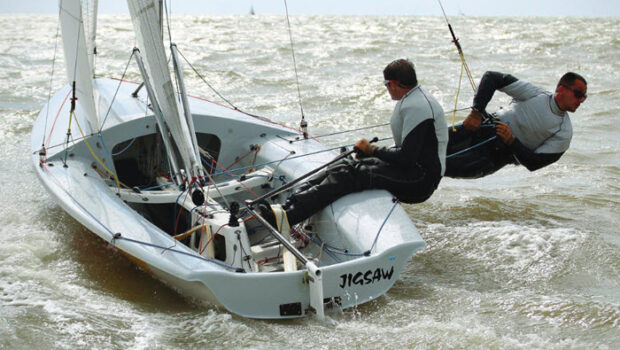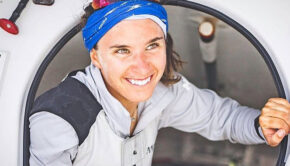Cents on the dollar
Published on December 17th, 2023
The sailing world is awash with former championship-standard racing dinghies and one-design keelboats sitting immaculate but dusty in garages – and all virtually worthless in the current environment.
In the August 2021 edition of Seahorse magazine, editor Andrew Hurst argues for his UK publication that with a single bold stroke of simple mathematics we can bring these boats back into use and help to stem the flood of teenagers leaving the sport. Two years later, this idea still has legs…enjoy:
A while ago a group of (us) mature dinghy sailors were batting around thorny issues of youth dinghy sailing, the high entry barriers, weak club fleets, the predominance of handicap racing. Looking at how to make racing for teens more interesting, more fun, and above all, cheaper.
We had a go at another related problem too, replicated elsewhere but rife here in the UK where we have nurtured it to Olympian levels: the over-supply of sailing clubs. We will talk about clubs and organizational structures at a later date. For now, I want to focus on the more urgent topic. Boats and sailors on the water; getting them there. And keeping them there.
After being fortunate enough to have raced at most of the great offshore events like the Kenwood, Sardinia, and Admiral’s Cups, this diverse sport now allows me to equally enjoy (very) Corinthian Finn racing at a small local club, tidebound up a Solent creek.
Racing for fun… launch, a couple of gentlemanly races, maybe 45 minutes each, then back to shore to sit on the lawn, imbibe and talk nonsense. Most races take place on handicap, as now do the majority of club races in the UK, a country that once boasted the biggest one-design fleets in the world, bar none.
I used to find watching so many clubs revert (as I saw it) to handicap racing very dispiriting. Now I believe it brings with it a potentially precious silver lining.
General consensus has it that as many as 80 percent of Optimist sailors stop sailing altogether once they grow out of the class. Now that really is dispiriting.
Some return in later life but much of the teenage contingent who were once the lifeblood of every dinghy club (ashore as well as afloat) are leaving. As a consequence, many once great clubs are today social and sporting deserts, heartbreaking to visit if you knew them in their pomp.
Why, you ask, don’t these lost teenagers just step up into ‘big fun’ 29ers, more staid but exhaustingly competitive 470s, or maybe 420s for the youngest? What about those foiling Moths, or perhaps a fast non-‘Olympic pathway’ one-design like the 505? Why not stick around?
You may be out of touch
Over the past 20-odd years, large swathes of dinghy racing have become unpleasantly elite. Most have seen the motorhomes and top-of-the range 4x4s, often with an enclosed boat trailer that populate big Opti regattas. Similarly, the next rungs of the Olympic pathway, 420s, 470s, 29ers, 49ers. There’s only one way to race on the circuit and that is flat-out. This means the very best gear, regular replacement of hulls, foils, sails and spars and frequently an expensive albeit first-class coach and a family-owned RIB. And new boats are very, very expensive.
If your parents cannot afford all that, and most parents cannot, then what is there left for today’s young adrenaline junky? Even to keep them in the sport long enough to just taste any adrenaline at all… to reward them for spending years getting up at silly o’clock each weekend to sail at 3 knots in a box? Not very sexy that, either, as nipper gets a little bit older.
Similarly, many of those parents who can summon up the thousands of pounds needed to carry on ‘pathway’ racing may recognize that their offspring is in truth a little lukewarm about the whole thing. The equestrian world is littered with parents trying to recover some of their (think up to £25,000 per hoof) outlay on that championship-winning pony for Tabatha… just as Tabatha discovers Rupert.
So, parents may not wish to, or, in the majority of cases, simply cannot afford to offer what their happy Opti sailor may now see as the only sailing on offer. No wonder that 80 percent leave the sport.
Limited toolbox
So, then I looked at what it would cost to buy a new world championship level 505. With all the bits added in, we are talking a very minimum of £30,000, realistically more. For our US friends, the equivalent number is around $50,000. In both cases, these are numbers that roughly represent each country’s national average wage…
A 505 is an awesome racing dinghy, furiously fast, huge old-school kite, demanding as hell to sail quickly but, importantly, just as much fun to take out for a blast during half-term when your mates are about and the breeze is up.
Wind the clock back: in the 1980s, Mark Lindsay and Larry Tuttle were turning out incredible (and incredibly durable) 505s at around $3,500-4,500, which before you ask is $10,000 in today’s money.
But please, do not castigate your boatbuilder for profiteering. They are making no more profit than 20, 30 even 40 years ago. Fact is, far fewer racing dinghies are now being built outside the manufacturer one-design classes, and far superior but far more expensive materials are now the norm. That boat has sailed (soz).
If you want a more striking example of what an elite, privileged activity the top level of small boat racing is in 2021, check out a fully-loaded foiling Moth. If you want a boat capable of winning the world championship, you will be lucky to see change out of US$60,000 (not a typo). With an all-up weight of 30kg, that’s a lot of bucks per kilogram.
So, with even the most exciting non- Olympic dinghies now priced through the stratosphere, why should we ever expect a return to the big club fleets of the 1970s, ’80s and ’90s? Yet without significant new growth, more sailing clubs will go to the wall or, in my own experience, simply become too depressing to visit.
Think tumbleweed, a rotting GP14 or Enterprise or two, plus some straggly beards (pick your gender) propping up a grubby bar with a two-year-old sausage roll morphing seamlessly into penicillin inside a greasy food warmer.
Under your nose
Perusing the lighter end of the world of sailing porn one evening, I was surprised by an advert for a tidy ’90s Rondar 505 with good club-racing sails at an asking price ‘offers considered’ of £650 (US$950), including top and bottom covers and a roadworthy trolley-trailer. Now intrigued, I soon found more ex-championship level dinghies for sale at and sometimes less than £1,500-£2,500. It got me thinking.
I am not talking here about knackered ‘old shitters’*. Not at all. Garages across England, and no doubt elsewhere, are full of superb examples of fast trapeze and non-trapeze dinghies, past their competitive prime but still immaculate, dry as a bone without a hint of rot, and with plenty of still good sails sitting in the rafters.
Think international Fireballs and 470s and 505s as well as some more esoteric national classes, which in the UK include boats like the National 12 and Merlin Rocket… two classes that are also a joy to sail, fast in the light and an enjoyable handful in a breeze (and, for handicap racing purposes, both these designs also point like hell.)
At face value, such boats can surely be interesting to some of our ‘ex-Olympic pathway’ youngsters? (In emerging sailing nations, there are hordes of youngsters who’d bite your arm off to call such a boat their own.) Of course, there is a ‘but’.
The two-tier solution
But… to generate that interest, what we must do is make these affordable packages genuinely competitive.
There are a handful of examples where tweaking handicaps to favor older boats has paid dividends. For some years, the Finn class has operated a simple three-tier approach for boats of different denominations. All compete against each other with different ‘ratings’ and similarly are separately handicapped at open class events.
But there are budget opportunities for class racing too. For keelboat aficionados, we previously covered a US revival of local Soling fleets in Seahorse. Closer to home, a few miles from our offices there is a healthy J/24 ‘revival’ fleet enjoying good racing every weekend. Cost… most of the boats were purchased and fettled for no more than £5,000 apiece. There are other J/24 revival fleets elsewhere in the world.
Across La Manche from us there is a corner of Quiberon Bay in Brittany where several dinghy clubs got together to corner the market in Laser 4000s. A cracking little starter skiff, not the latest game in town and a bit chunky on the slipway, but boats cost cents-on-the-dollar to buy com- pared with comparable newer alternatives like a 29er or 49er.
And the result of this initiative by our French friends? Often as many as 30 to 40 spruced-up Laser 4000s are now out on the water on a sunny weekend.
Big fun and a far lower entry cost for parents of youngsters who love to sail but cannot afford to take the ‘apparent’ next step, as well as parents with offspring not yet convinced this is the sport for them. Laser 4000s still go fast, feel faster and the odd minor crunch, well, so what?
Back to the handicap picture
So, in the UK at least we have a plentiful supply of excellent, pretty foxy (fancy a 420, nipper? Seriously, Daaaad?) and well- kept non-Olympic dinghies. We have a plethora of ex-Opti teenagers for whom a fully loaded 29er is for the birds and who will now be lost to the sport.
And, we have club fleets that even after the transition to handicap racing are confronted with poor turnouts… Which will usually also mean much reduced bar and general revenue.
A handful of big-bucks newer dinghies will always turn out at these clubs, owned by the lucky few, usually older sailors. But what if younger sailors could access these very same classes at a fraction of the cost and still have a real shot at winning?
How hard is it? (There might be a few forces of darkness ahead – not all those investing thousands in new kit will rush to let go of the prizes. But hopefully not.)
Pulling it all together
But to play our new game we need to do more than create a level playing field. To generate the major resurgence we are after, now we must tilt the playing field in favor of our young – and older – ingenious.
We must give the older boats a new and now favorably biased handicap number, one that allows our polished-up £1,500 championship Fireball to enjoy a better- than-evens chance of winning. It may be controversial but the rewards could be enormous in every sense.
I believe that right now this is absolutely our best shot at growing club fleets by a worthwhile amount, and also encouraging teen sailors and doubtful parents.
At risk of repeating ourselves
Like the Finns with their three-tier system, I strongly urge clubs to at least give this idea a go and experiment with their own tiered system, class by class.
Initially, relative handicap numbers can be recommended by a national authority, by a class association or, in the spirit of a fresh approach, they can be estimated by someone at your club sticking a finger in the air; the starting figure can easily, no software required, be refined with the benefit of experience (which Seahorse readers may have spotted is pretty much how the globally successful IRC system evolved).
Suddenly our £650 505 is not only affordable, but with a single stroke we have just made it fully competitive.
All top-level dinghy racing takes place on real time. Handicap racing at a high level is for big boats where demographics dictate the format. Handicap or pursuit racing in small boats is enormous fun and is perfect for swathes of clubs in the modern environment, but it must always be taken with a pinch of salt. By offering a favored ‘handicap rating’ for an older boat we won’t ruin anyone’s ‘career’ in the sport. For once let’s play the whole game, not just our own part of it.
Clubs can embrace this idea with little or no effort and see what follows. Take it seriously. Ask members and parents, think which boats are most suitable for your waters and for the sailors who you are trying to attract. Take note of what parents and youngsters say they want to race.
Don’t be influenced by the current fleet. This is handicap racing, remember. Then contact class associations and peruse the web. The owners of those countless dry- stored dinghies will be oh-so-grateful to get a call from you. Trust me!
In preparing this article, I spoke to some class associations. All were enthusiastic and ready to help; in fact, they are ready to endorse anything that gets a few more well cared-for boats further from the bonfire and back onto the water.
And that gives their members a little cash (plus some garage space). All offered help sourcing good boats. All made the point, too, that the good boats are now rarely advertised – the owners have simply given up.
The class associations know where good examples can be found. And then bought for cents on the dollar.
Now get on with it
Why not ask your club to discuss two-tier handicaps. What can it cost? It may lead to a stronger fleet, a stronger club, more youngsters to feed the machine… and less angst for parents seeing no way to help their children continue in a sport that they may just have fallen in love with…
More members sailing faster boats. And your teenagers (along with their parents) no longer disappearing each weekend to traipse around the country to finish 35th in a squad regatta. Maybe they like sailing more than they know?
Youth sailing does not have to be ‘Olympics or bust’. To be honest, in far too many cases it is now Olympics and bust. There are other ways and this is the best we can come up with.
*Old Shitters coincidentally (or not) being the name chosen for the eminent group referred to at the start of this article.
SOME FACTS
• Most Opti teens soon give up sailing.
• Reasons start with boring alternative boats and/or impecunious parents with doubts about a youngster’s enthusiasm.
• There is now a ready supply of cheap high-performance dinghies fast enough to tempt at least some of our former Optis – but only if they can win races.
• Because if they are to try an affordable flyer any normal youngster will need to know that they can (and of course will) beat swanky BMW-driving grown-ups!
CHOICES:
Olympic pathway (new boat)
Opti circa $10,000; 29er circa $20,000;
470 circa $25,000; 49er circa $40,000.
Non-Olympic pathway (new boat)
Tier 1 handicap – 505 $50,000; Moth up to $60,000; Fireball $30,000.
Non-pathway ‘Old Shitters’
Tier 2 handicap (favored) – a newly competitive 505 $1,500-6,000; good Fireball circa $2,500; good used 470 circa $4,000.
PRIZES
Tier 1 and Tier 2 handicaps shall be skewed to put modern Tier 1 designs at a slight disadvantage. Call it 18/20 in relative performance versus a well-sailed Old Shitter at 20/20. This is essential to drive the Tier 2 purchases where with luck the – your – fleet growth will come from.









 We’ll keep your information safe.
We’ll keep your information safe.